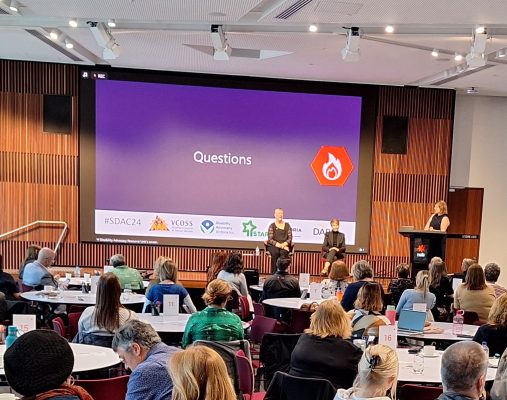
Keynote speech by Christina Ryan DLI CEO to the Strengthening Disability Advocacy Conference, 19 September 2024.
I acknowledge the Wurundjeri people of the Kulin Nation, whose beautiful country we are gathering on today. I also acknowledge other First Nations folk who are here with us.
We are at a crossroads in the disability rights movement. Many big processes have concluded and left many of us are asking whether these processes have taken us forward or back. We have also seen a shift in the disability advocacy sector and how it works.
We’ve had several years of major processes and reforms, including the Royal Commission, the NDIS review, the registered provider inquiry, more reviews of the advocacy sector, and most recently the NDIS legislation process. This has all been happening alongside our usual work of implementing the CRPD, engaging with the United Nations, and keeping in touch with our international colleagues about latest developments. A lot has been going on.
Many of us felt deflated with the government’s underwhelming response to the Royal Commission. We waited a long time for the government to work out how it would respond, and ultimately, they couldn’t even accept the recommendation that disabled people should be consulted. It has left a lot of people asking where to from here?
Disabled people fought hard for the Royal Commission. We then committed a lot of trust and energy to making sure it was the best we could make it. Then our various governments, state and federal, couldn’t find the courage to use it as a catalyst. Rather they seem to have found it awkward and inconvenient. Then other processes were forced upon us, sometimes with very short timeframes like the NDIS legislation changes, and we once again engaged in those reviews and legislative reforms to do the best for our community to move things forward in a positive direction.
It has been very difficult to see if we are achieving any real change with these processes. It is always hard to see change when we are right in the middle of things, when we are working flat out at the coalface every day doing our best to make things happen, but ultimately these processes have all contributed to change, some of it big and some of it incremental.
Let’s pull back to the bigger picture; our disability rights movement is about equality and how we are getting equal. So, what has been happening there? How have all these processes been making a difference to disabled people getting equal? Are we really implementing the CRPD?
Power
When I look back over the last decade one big change becomes obvious: disabled people are now expected to be in the room. A decade ago, we were knocking politely and asking that disabled people be part of the conversation, that we be a part of discussions about how our lives looked and how much we controlled them. I look back to the NDIS build process and recall that many of the working groups had one single disabled person on them, and often we had to fight to have that one disabled person in the room.
Disabled people now have power that we have never had before. We have gone from asking to be in the room, to expecting to be in the room. Sure, we are yet to be there in the numbers we should be, and we are rarely if ever there as the key policy designers and decision makers. We are not yet there as government ministers or heads of departments. We still have only 4 openly disabled parliamentarians across the 950, or so, members of Australian parliaments state and federal.
However, no process about disability is considered legitimate today unless disabled people are there. Our voices are stronger than ever. We have developed our own power.
What I am not seeing is the disability community using our power consciously or deliberately. Somehow, we are still tapping politely on doors and asking to have a say, just like we did a decade ago. It’s time to stop this, to recognise that we do have power and to start expecting to be part of the big conversations. Every disabled person in this room today has power and I would like to see you using it.
We have colleagues fighting right now insisting that the new CEO of Vision Australia is from the blind and vision impaired community. United Blind Leaders have circulated an open letter insisting that a transparent and accountable process is undertaken to achieve this.[1] You can sign it at change.org. (Update: the day before the conference, Vision Australia announced that it would change its recruitment process and also include being blind or vision impaired as a desirable selection criteria.)
The Deaf President Now campaign at Gallaudet University of the Deaf back in the 1980s was the result of many individuals standing up and saying, “we do not accept degraded status”.[2] They succeeded in getting the first Deaf person appointed as chair of the university board, because they refused to accept anything less.
Our New Zealand colleagues were appalled in 2022 when the head of the new Ministry of Disabled People was announced, and it wasn’t a disabled person. They fought hard for this ministry and did not want to see it going the way of other disability specific agencies. So, they refused to accept the appointment. They let the government know that the appointment wasn’t legitimate or credible and insisted that a disabled person be appointed. Within a few days the appointment was renamed as “interim” while a disabled person was found, and you bet they found one!
And who can forget Stop The Tram? A campaign that has recently been revived started in Melbourne in the 1990s to get accessible trams and stops. This campaign was an outstanding example of disabled people using our power to make change. A whole heap of people chained themselves to the front of Bourke Street trams in flash protests that held up traffic for hours. It changed a lot of things, including the national transport standards. Many of us now enjoy an accessible inner city Melbourne tram system as a result.
Throughout history, those in power have never given it away. Power is not ceded by those who have it. When it changes hands, it is because others have stepped forward, moved alongside and taken it. If disabled people want equality, if we want to be in the rooms of decision making about our lives then we must recognise our power, own it and start using it.
When we see appointments being made to disability specific or relevant roles, it is within our power to accept or reject those appointments. It is up to us to insist that disabled people are appointed to run our organisations, our service providers, our offices of disability, and to the various statutory appointments like commissioners for disability or heading our regulatory agencies like the safeguards commission. If we really want equality, it is also time we got into the parliaments and into the cabinet rooms.
When non-disabled people are appointed, we can say: “no, go back and do better.” Just as our forebears have done in various campaigns, we can reject others speaking for us or being in positions of power that make decisions about our lives.
We can also start saying no when policy or processes are not acceptable to us. When governments tell us they will only accept 13 of the Royal Commission’s recommendations we have the power to say: “no, go back and do better.” Not good enough.
Disability advocacy has also evolved. We have reached a point where it has become offensive for anyone other than disabled people to speak for disabled people. This includes frontline individual advocates, who now work using a rights based approach and understand that they do not speak “for” a person, but rather are there to support a disabled person to be heard, in line with the CRPD expectation of support being provided so that a disabled person can engage in a particular system or process.
Our allies have become those who step back and make space for us to be in the room, to be heard, to be respected as equals. Our allies help us to do our work, hep us to be strong, support us to show up. They have our backs and make our work possible. In the disability community allies do vital work that makes it possible for disabled people to do our work getting equal, but they do not and cannot do our work. They do not have the expertise of lived experience.
Those who are not our allies, who are not creating space, are not supporting us and putting us forward are lagging behind and it’s time for them to go back, have a think and come back when they are ready to do better.
Disabled people are no longer prepared to ask, we now expect those who are making decisions that affect us to be us.
Productivity
Australia is having a productivity crisis. For at least 20 years we have been struggling to improve our international competitiveness. For even longer we have been towards the back of the OECD pack when it comes to disability employment. I sometimes wonder if solving disability employment might not also assist with improving our international competitiveness and productivity.[3]
Australia needs our disabled people to be part of fulfilling our potential as a country. This isn’t just a buzz phrase; it is a serious economic problem. Around one fifth of the Australian population struggles to find work and struggles to build careers in our chosen fields. With around 5 million Australians with disability, we are talking big numbers who are not contributing as we would like to.
Disabled people are needed, and yet we are shut out from being part of the solution. We don’t just find it hard to get work, we are rarely seen in any senior leadership positions, whether it is in the public, private or community sector. We must start with our advocacy organisations and our service providers, while also looking at any government position related to disability. If disabled people are not being appointed, we should be asking why, reject the appointments, and send recruiters back to do better. This needs to happen for the country, not just for us and getting equal.
Reputable studies have shown that disabled people are 10 per cent more innovative in the workplace than the people we work alongside.[4]
A more recent study showed that when disabled people are team leaders and supervisors, our teams are far more productive.[5] When those teams are also largely teams of disabled people, they become even more productive.
So why isn’t Australia going full pelt on building our disability leadership and our disability workforce, right across all sectors?
For at least the last 3 decades the Australian policy push has been for entry level employment. What I call the “get a job” policy. Yet, various studies show that to generate culture change and build more inclusive workplaces you need diverse leadership. Studies also show that disability leadership provides for greater innovation and productivity.
Disabled people aren’t superhuman, but we do see things differently and we are outstanding problem solvers. We are great at finding workarounds and making systems work. Disability leaders are masters of flexibility and adaptability to circumstance. If you want something done, a disability leader will find a way to do it.
We also know that diverse leadership is the key to building and sustaining a diverse workforce. Yet, for some reason Australia is lousy at appointing disabled people to senior positions, whether it be in government, corporate, community or academic sectors. Everyone seems to be talking diversity; except they keep forgetting disability diversity. When they do talk disability diversity, they don’t mean leadership, they mean entry level. Yet it is when we have disabled people in leadership positions that productivity and innovation increase. Why isn’t Australia getting the message?
Well let’s make sure it does.
We need disabled people across all fields, across all sectors, and in our parliaments. That means you, me, all of us. This must become our frontier work, the tough and difficult job of being the first, and often only, disabled person in your workplace or at your level, but it must be done. The job of the disability rights movement is to support each other as we infiltrate all of these systems, workplaces, and institutions. It’s a long game and it is going to be a tough fight, but it’s one we must take on to tackle the continuing ableism and prejudice that continues to govern our lives.
More and more disabled people are being open about their disability at work, and we must recognise how hard it still is for people to be doing this. By backing each other through our networks, our community and our professional organisations like the Disability Leadership Institute we can make it easier for the next person and the one after that.
When people on the inside are unable to speak out, our advocates and change makers can. We are going to need both contributions to get to where we are going. The disability rights movement is big and diverse, and it is going to take all of us, across all of our intersectional spaces, to get to the equality we are looking for.
We can start by saying no and expecting better.
It is time we expected to be in board rooms, executive offices and in parliaments as decision makers, not just about disability but right across all fields because that is what Australia really needs if we are going to be a powerhouse 21st century economy.
Disabled people are in a very different position to where we were a decade ago. We now have power and a voice, and we must learn how to use it. It is time we told the organisations and governments that affect our lives to go back and start doing better.
Thank you
[1] https://www.theguardian.com/australia-news/article/2024/aug/31/vision-australia-pressed-to-appoint-a-blind-ceo-and-open-field-externally
[2] https://gallaudet.edu/museum/history/the-deaf-president-now-dpn-protest/
[3] https://www.ceda.com.au/newsandresources/opinion/economy/why-australia-critically-needs-a-productivity-push
[4] https://hbr.org/2017/12/the-case-for-improving-work-for-people-with-disabilities-goes-way-beyond-compliance
[5] https://theconversation.com/job-supervisors-with-disabilities-can-boost-productivity-new-research-shows-236764





